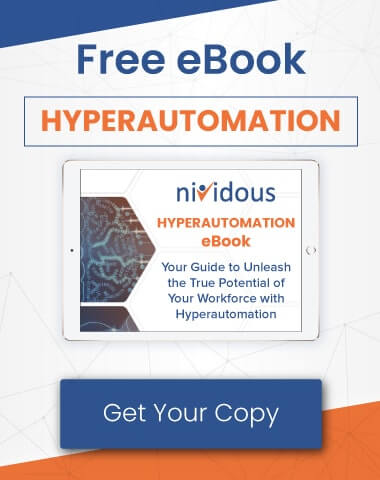Any executive will tell you that enterprise digital transformation ranks high on their list of initiatives—but a few years ago, it may have been a distant intention, something to get to when the quarter’s goals were well in hand. However, the COVID-19 pandemic made digital transformation an urgent necessity. A 2020 survey asked business decision-makers if the pandemic “sped up digital transformation” at their organizations. Here were the responses:
- Yes, a great deal: 68%
- Yes, somewhat: 29%
- Other: 3%
With 97% of survey respondents saying COVID-19 took digital transformation from a “nice-to-have” to a “must-have,” you can be sure the trend is real—and, given the benefits and the fast pace of technology growth, it’s here to stay. But like all industry buzzwords, “enterprise digital transformation” means many things to many people. As a global intelligent automation company with more than 25 years at the forefront of digital process automation technology, we have a lot of thoughts on the subject. Here’s our take on what enterprise digital transformation really means—and how you can pursue it at your company.
Curious about how end-to-end process automation contributes to digital transformation?
Talk to Nividous to discuss the benefits
1. What is enterprise digital transformation?
When the concept of enterprise digital transformation first surfaced, it was synonymous with digitization itself. Large companies that operated on mountains of paperwork—complex filing systems and offsite archival storage—began moving toward digital data storage as far back as the 1960s, when databases started to become available. The trend became the norm for companies of all sizes after 1996, when digital storage officially became more cost-effective than paper files.
Still, digital transformation as a concept didn’t quite go viral until the 2010s, when new automation technologies began to mutate the definition of the term. Today, enterprise digital transformation refers to a digital-first mindset for improving operations—and, more often than not, that includes digital automation. The specific digital transformation projects may change as new, smarter technologies become available, but the effort remains ongoing and focused on Information Technology (IT) to complete business processes faster, cheaper, and more accurately. Today, digital transformation technology includes Robotic Process Automation (RPA), Business Process Management (BPM), and Artificial Intelligence (AI)—which, when combined, lead to intelligent automation for end-to-end processes.
2. How has interest in enterprise digital transformation changed over the years?
Google searches for “digital transformation” started a long upswing around 2014, which is also around the time RPA really started to take off. Between 2013 and 2015, the compound annual growth rate of RPA adoption grew by more than 100%, according to a contemporary Everest Group report. It was an early indication of the technology’s appeal.
Meanwhile, as the chart below demonstrates, interest in Google searches for “digital transformation” began to climb around 2014, reaching peak popularity (a search interest score near the maximum 100) in 2021. This chart also shows that search interest in “robotic process automation,” while lower overall, grew during the same time period.
These search figures lead to another interesting question: Who’s searching for the term? There’s no hard data available, but our experience tells us that the concept of digital transformation has gone mainstream. Whereas those few searches from 2004 and 2005 probably came from Fortune 500 companies on the cutting edge of technology initiatives, today’s leaders at mid-sized and small businesses are interested, too.
As technology costs come down and the possibilities of AI expand, enterprise digital transformation becomes available for everyone—whether you consider your company an “enterprise” or not. In fact, “enterprise” doesn’t refer to the size of your operation. In the context of digital transformation, it means something that applies to every business.
3. What puts the “enterprise” in enterprise digital transformation and enterprise IT automation?
Digital transformation may refer to discrete digitization efforts: automating a single task or moving to new digital business channels. When you add the qualifier “enterprise” to get enterprise digital transformation, however, you’re talking about a company-wide initiative. (Enterprise IT automation is another common term that refers to the same process.)
This is a holistic approach that changes everything from communication with clients, partners, and other stakeholders to workflow management. Enterprise digital transformation applies to the entire operation, coordinating processes and workers through digital platforms.
That may sound intimidating, but it’s easy to get started. Here’s a quick digital transformation guide that can put any company on the path to more efficient operations using automation technologies. If you’re looking for a more detailed digital transformation methodology PDF, try this strategy guide from Gartner®.
4. What is the first step toward enterprise digital transformation?
Lots of companies have less-than-stellar experiences with early digital transformation efforts. Maybe you’ve spent millions on a new ERP platform or hard-coded system integrations, only to find them obsolete shortly after roll-out. There’s a better way to manage risk on your next attempt. If enterprise digital transformation starts with digital automation, start building a business case by automating a single process, assuring all risk is limited and quantifiable—and the rewards are shown in hard numbers.
The Nividous Quick Start Program is a quick, low-risk way to gauge the effectiveness of digital transformation with RPA. It guarantees the roll-out of a trained RPA bot that automates a high-value business process within just three to four weeks. There are four steps to the program:
1. The Nividous team works with you to identify the best processes for RPA.
Start automating with a process that delivers powerful results, both in terms of RoI and day-to-day benefits. That’s probably a process low in complexity, with just a few related systems, but very high in business value—something in the Accounts Payable department, perhaps, like processing invoices or purchase orders. One media company automated release order processing with Nividous RPA and realized a 60% reduction in manual work, 50% savings on labor costs, and turnaround times that were 75% faster. We’ll find processes with similar promise for your company, all in a short workshop session.
2. We document the entire process from start to finish.
RPA bots work through user interfaces, automating keystrokes and navigation elements to integrate any type of software. To train a bot for your unique use case, we’ll document these digital steps, taking note of all activities, rules, trigger values, inputs, and outputs—all within one or two days. Once the existing process is fully documented, we look for any possible optimizations and document the process as it will be automated. This is often referred to as the to-be process. You’ll sign off on the as-is and to-be processes, and we’ll move to the next step.
3. We build, train, and implement the RPA bot to begin automation.
Within the framework of agile methodology, the Nividous team will develop, train, test, and implement the RPA bot through the Nividous intelligent automation platform. In short, we build the bot. This process is completed in two or three weeks at most.
4. We complete the automation roll-out.
Together, we run the automation through test cases and find exceptions, then tweak the process to handle them. You accept the final RPA implementation, and our team trains your staff to operate the platform once the engagement is complete. The roll-out process is completed in two to three days—and once it’s done, the Nividous platform tracks performance with automated reporting tools. That way you can get hard data on the success of your first automation.
Reporting data helps you build a business case for end-to-end process automation across your entire operation. That’s the first step toward total enterprise digital transformation, and with the Nividous Quick Start Program, you can begin with a fixed price, plenty of support, and a guarantee for production.
Of course, a single process automation is just the first step.
5. How do you direct digital transformation across the organization once you have proof of concept?
By definition, enterprise digital transformation aims to improve operations across the entire organization. That requires central management, open communication, and stakeholder buy-in from everyone at the business—not a strict top-down edict, but also not a decentralized, bottom-up approach, which tends toward the ad hoc.
A Center of Excellence (CoE) for digital transformation is a cross-functional team representing all affected parties, from the C-suite to IT to frontline employees who will collaborate with RPA bots to complete processes more efficiently. The CoE’s purpose is to optimize the benefits of digital automation while scaling it across the organization.
While staff assigned to your CoE will track key performance indicators and establish best practices for automation implementation, their most important role is to coordinate and share knowledge about the changes wrought by digital automation. They’re not building the new systems; they’re spreading the message and ensuring that all stakeholders remain engaged and enthusiastic as you pursue enterprise digital transformation.
Need help setting up an automation COE?
Or automating business processes from the ground up? Set up a free consultation with the Nividous experts.





